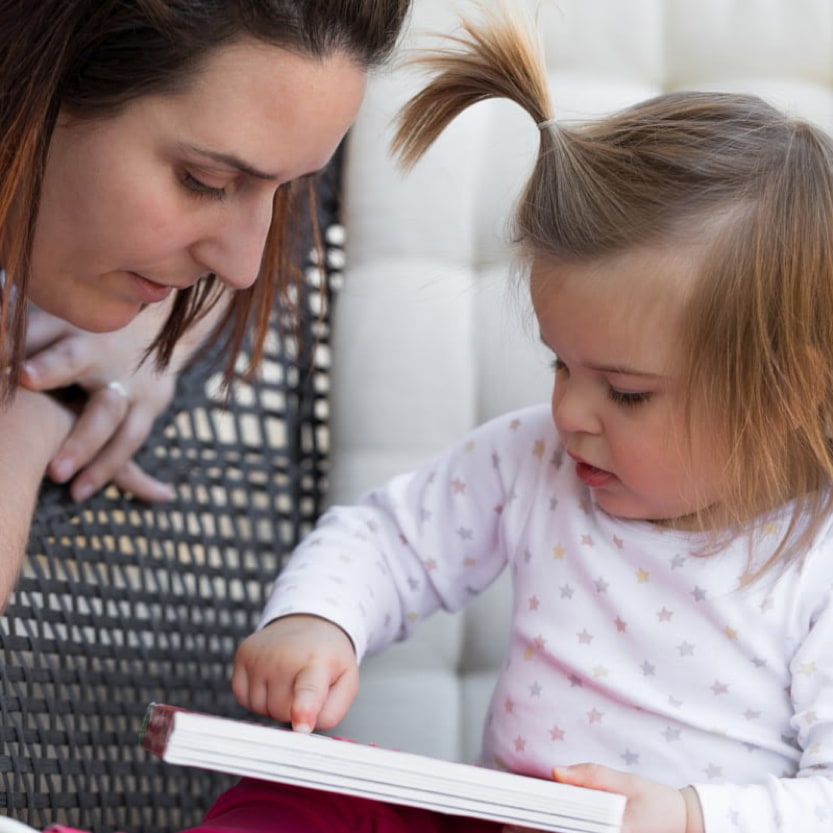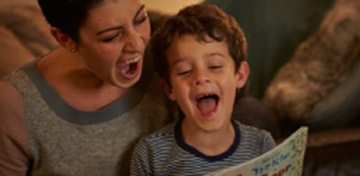A book or three when tucked up in bed is a lovely way to end the day. Snuggling up for a bedtime story is also a brilliant excuse for some cuddle time – not that you need an excuse! Those early evening moments will help them feel relaxed and settled, and bring the two of you closer. Their love for books and reading starts right here.
Tips for bedtime stories
Tip #1: A book and a cuddle every night
Try making story time part of your bedtime routine. Cosying up with a book lets your toddler enjoy a cuddle and hear your voice as you read the story.
Tip #2: A soft voice
Reading to them in a soft voice helps them feel calm and sleepy. That also means picking a story that’s not too wild and exciting. Pirates vs dinosaurs is probably not a good choice.
Tip #3: Short and sweet
It doesn’t have to be a long story, or have words at all if they’re really wee. Start by pointing out and talking about the pictures – that works well as a quick and easy way to get them interested.
Tip #4: Question time

Ask questions to keep them interested and get them thinking about the story. The simpler the better. Where is the main character going? What are they wearing? Can you remember their name?
Tip #5: New words
Try building your little one’s bank of words with questions like 'Did you see that yellow car?' or 'What colour is that tractor?' You might think they don’t know what the words mean, but babies’ brains are like wee sponges – you’d be amazed what they pick up even when they’re tiny.
Tip #6: Let them turn the pages
While you’re reading, take your child’s hand in yours and run their fingers along the words as you read. When you get close to the end of the page get them ready to help you turn it over. This can be very exciting, particularly if it is a picture book.
Tips for getting them ready to read along
Tip #1: Repeat repeat repeat

Children love to hear the same story over and over again. While that can be pretty boring for you, it really helps them learn about books. First they’ll notice the pictures, then they’ll learn to turn the page, and before you know it they’ll be finishing the sentences then reading along with you.
Rhyming books are brilliant for that because they can start reading along without even noticing.
Tip #2: Role reversal
Let your little one read to you. Even if they’re just making up their own story they will be going through the movements of reading. Get them to turn the pages and run their finger along the words. They might even want to show you how the pictures on the page fit into the story they are telling you.
Tip #3: Show them the words
Running your finger along the words as you read helps to show your child where the story is coming from. When you pick a book, show them the words on the cover and ask them to guess what the story might be about. They may not be able to sound out the words but they will get used to the idea that words are made of different sounds.
Tip #4: Try videos
There are lots of great videos online which show the story being told while the words appear below the action. Try pausing the video and sounding out the words for your child.
Tips to keep them concentrating
Tip #1: Build a fort
If you’re trying to settle down for some reading, tire them out by getting them to build a fort to read in. This will be their own special wee space that they’ll want to spend time in. Maybe reading a book about castles or caves would go perfectly with this new hidey space?
Tip #2: What happens next
Get your little one to tell you what they think will happen next. If they know the story and they guess right, praise them and run your finger along the sentence that confirms their guess. Try sounding out the words as you point to them.
Tip #3: Ask questions
When you have finished a page, ask your little one some questions about what you’ve been reading. Asking them who their favourite characters are, or what colour something might be keeps them interested and listening.
Tip #5: Carry books for them and you
We always try and have a wee book with us so that if we're on the bus or waiting at the doctors we can get it out to distract them for a bit.
 Activities & Play
Activities & Play Behaviour
Behaviour Childcare
Childcare Development & Growing Up
Development & Growing Up Family, Friends & Relationships
Family, Friends & Relationships Feeding Your Baby
Feeding Your Baby Food & Eating
Food & Eating Health & Safety
Health & Safety Mental Health & Wellbeing
Mental Health & Wellbeing Money & Work
Money & Work Online Behaviour & Safety
Online Behaviour & Safety Pregnancy & First Days
Pregnancy & First Days School & Education
School & Education Sleep
Sleep










 Family, Friends & Relationships
Family, Friends & Relationships
 Mental Health & Wellbeing
Mental Health & Wellbeing